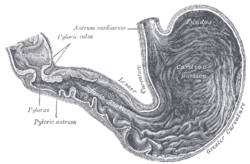| Pylorus | |
|---|---|
 Inside of the stomach (pylorus labeled at center left) | |
| Details | |
| Synonym | Pyloric region, pyloric part |
| Identifiers | |
| Latin | pylorus |
| Greek | πυλωρός |
| MeSH | D011708 |
| TA98 | A05.5.01.017 |
| TA2 | 2930 |
| FMA | 14581 |
| Anatomical terminology | |
The pylorus (/paɪˈlɔːrəs/ or /pɪˈloʊrəs/) connects the stomach to the duodenum. The pylorus is considered as having two parts, the pyloric antrum (opening to the body of the stomach) and the pyloric canal (opening to the duodenum). The pyloric canal ends as the pyloric orifice, which marks the junction between the stomach and the duodenum. The orifice is surrounded by a sphincter, a band of muscle, called the pyloric sphincter. The word pylorus comes from Greek πυλωρός, via Latin. The word pylorus in Greek means "gatekeeper", related to "gate" (Greek: pyle) and is thus linguistically related to the word "pylon".[1]